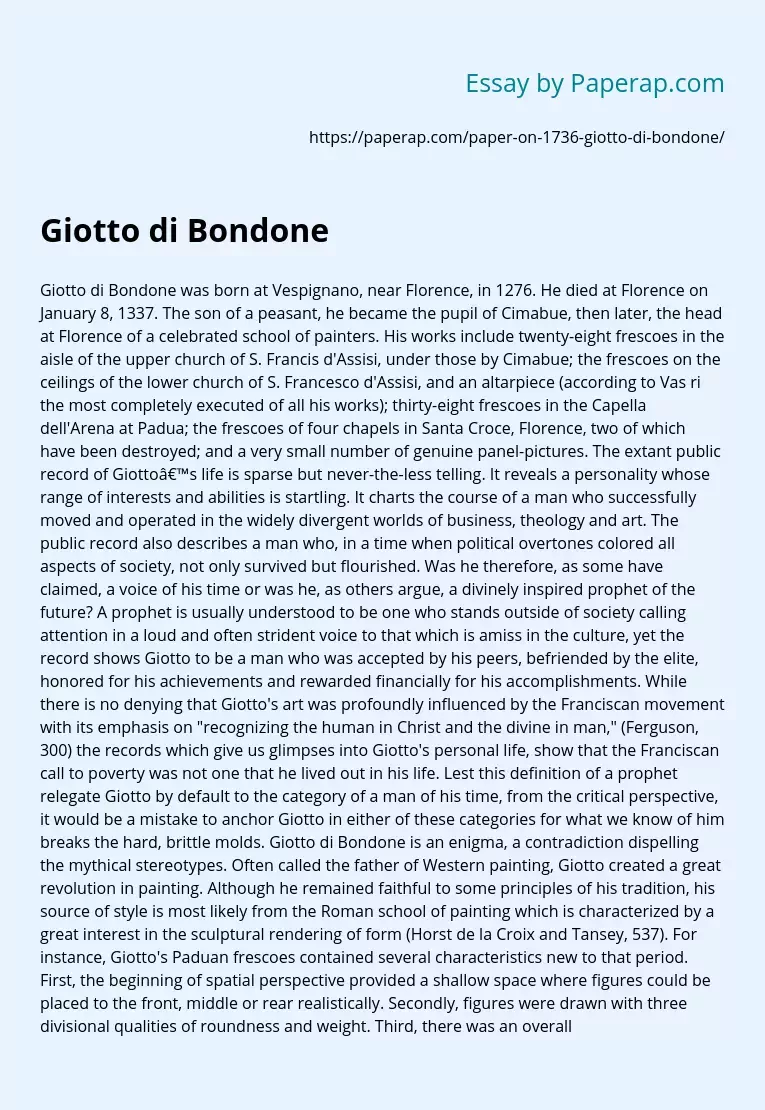Giotto di Bondone
Giotto di Bondone was born at Vespignano, near Florence, in 1276. He died at Florence on January 8, 1337. The son of a peasant, he became the pupil of Cimabue, then later, the head at Florence of a celebrated school of painters. His works include twenty-eight frescoes in the aisle of the upper church of S. Francis d’Assisi, under those by Cimabue; the frescoes on the ceilings of the lower church of S. Francesco d’Assisi, and an altarpiece (according to Vas ri the most completely executed of all his works); thirty-eight frescoes in the Capella dell’Arena at Padua; the frescoes of four chapels in Santa Croce, Florence, two of which have been destroyed; and a very small number of genuine panel-pictures.
The extant public record of Giotto’s life is sparse but never-the-less telling. It reveals a personality whose range of interests and abilities is startling. It charts the course of a man who successfully moved and operated in the widely divergent worlds of business, theology and art.
The public record also describes a man who, in a time when political overtones colored all aspects of society, not only survived but flourished. Was he therefore, as some have claimed, a voice of his time or was he, as others argue, a divinely inspired prophet of the future? A prophet is usually understood to be one who stands outside of society calling attention in a loud and often strident voice to that which is amiss in the culture, yet the record shows Giotto to be a man who was accepted by his peers, befriended by the elite, honored for his achievements and rewarded financially for his accomplishments.
While there is no denying that Giotto’s art was profoundly influenced by the Franciscan movement with its emphasis on “recognizing the human in Christ and the divine in man,” (Ferguson, 300) the records which give us glimpses into Giotto’s personal life, show that the Franciscan call to poverty was not one that he lived out in his life. Lest this definition of a prophet relegate Giotto by default to the category of a man of his time, from the critical perspective, it would be a mistake to anchor Giotto in either of these categories for what we know of him breaks the hard, brittle molds.
Giotto di Bondone is an enigma, a contradiction dispelling the mythical stereotypes. Often called the father of Western painting, Giotto created a great revolution in painting. Although he remained faithful to some principles of his tradition, his source of style is most likely from the Roman school of painting which is characterized by a great interest in the sculptural rendering of form (Horst de la Croix and Tansey, 537). For instance, Giotto’s Paduan frescoes contained several characteristics new to that period.
First, the beginning of spatial perspective provided a shallow space where figures could be placed to the front, middle or rear realistically. Secondly, figures were drawn with three divisional qualities of roundness and weight. Third, there was an overall surface pattern which emphasized the main features of the action, such as the direction of movement of figures against a partially realistic landscape. Finally, there was a continued awareness of the allegorical, symbolic or figural significance of the subjects of the painting (Holms, 210).
Traditionally, medieval art was an art of copyists, “of the transcription of traditional picture cycles into a more or less individual idiom” (Gombrich, 150); however, in all styles the artist has to rely on a vocabulary of forms, and that it is the knowledge of this vocabulary rather than a knowledge of things that distinguishes the skilled from the unskilled artist….
What is more, it remains important that there exists a natural pull toward the schematic which artists such as Giotto… succeeded in overcoming” (Gombrich, 293). In Italy, the new developments in art have been traced to panel-paintings and to the frescoes and other such monumental forms of art: If the most decisive moment in the history of Western painting had to be pinpointed to one day and one place, it could be the day in Padua more than six and a half centuries ago when Giotto rinsed out his brushes and took a last look around at the cycle of frescoes he had just completed for a chapel….
In the lower section of the fresco on the chapel’s entrance wall, where the Last Judgement is pictured, Giotto makes clear that the building is a placative gift (Canaday, 6). In Giotto’s fresco cycles framed scenes are linked much as Dante joined the cantos in his epic poem, the “Divina Comedia. ” Also, the narrative style demanded a convincing setting and Giotto’s perspective represented a method of depicting a scene from a certain vantage point.
The narrative style was developed by the fourteenth century artist in order to depict a greater naturalness and intensified dramatic expression in his painting and to bring the heavenly subjects within the realm of understandable human feeling (Canaday, 5). The best early example of this style is Giotto’s fresco paintings in the Arena Chapel in Padua where the individual scenes on the chapel walls provide a “majestic progression of the story from one section to the next… with each incident conceived in its own emotional air just as a unit in a… symphony” (Canaday, 6).
The story is told with technical realism, tenderness and a passion that involves the viewers as vicarious participants. The human drama which has been elevated to a noble scale, “purifies us through pity, if not through terror” (Canaday, 12). Because of this, Giotto is called the first Renaissance artist in that he humanized the narration of the Christian story and in doing so, opened a tradition of reference to nature. As a great artist also in the classical tradition, he “ennobled man in his physical being as a vessel of the intellect and the spirit” (Canaday, 12).
Giotto di Bondone. (2017, Jun 04). Retrieved from https://paperap.com/paper-on-1736-giotto-di-bondone/

